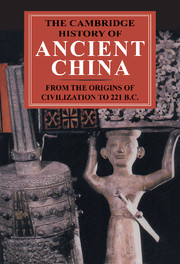Book contents
- Frontmatter
- Introduction
- 1 China on the Eve of the Historical Period
- 2 Language and Writing
- 3 Shang Archaeology
- 4 The Shang: China’s First Historical Dynasty
- 5 Western Zhou History
- 6 Western Zhou Archaeology
- 7 The Waning of the Bronze Age: Material Culture and Social Developments, 770–481 B.C.
- 8 The Spring and Autumn Period
- 9 Warring States Political History
- 10 The Art and Architecture of the Warring States Period
- 11 The Classical Philosophical Writings
- 12 Warring States Natural Philosophy and Occult Thought
- 13 The Northern Frontier in Pre–Imperial China
- 14 The Heritage Left to the Empires
- Bibliography
- Index
- Map 1 Topography of China
- Map 3.1 Archaeological sites of the Early Bronze Age
- Map 6.1 Archaeological sites of the Western Zhou period
- References
1 - China on the Eve of the Historical Period
Published online by Cambridge University Press: 28 March 2008
- Frontmatter
- Introduction
- 1 China on the Eve of the Historical Period
- 2 Language and Writing
- 3 Shang Archaeology
- 4 The Shang: China’s First Historical Dynasty
- 5 Western Zhou History
- 6 Western Zhou Archaeology
- 7 The Waning of the Bronze Age: Material Culture and Social Developments, 770–481 B.C.
- 8 The Spring and Autumn Period
- 9 Warring States Political History
- 10 The Art and Architecture of the Warring States Period
- 11 The Classical Philosophical Writings
- 12 Warring States Natural Philosophy and Occult Thought
- 13 The Northern Frontier in Pre–Imperial China
- 14 The Heritage Left to the Empires
- Bibliography
- Index
- Map 1 Topography of China
- Map 3.1 Archaeological sites of the Early Bronze Age
- Map 6.1 Archaeological sites of the Western Zhou period
- References
Summary
This volume describes a history of ancient China, though the term China, as the name of a modern country, did not exist until recent times. The civilization that we have come to identify with present-day China began to be formed perhaps a few thousand years ago, but its geographic scope has undergone continuous change, at no other time coinciding with the present political borders. Therefore, it should be borne in mind that in this chapter the geographical stage here called China is more like a short-hand name for one part of East Asia, east of the Altai Mountains and the Tibetan Plateau. This is an area where early hominids came to settle, as they did in the rest of Eurasia, furnishing the basic populations among which an agricultural way of life began some ten thousand years ago. It is only then that one begins to recognize with in this area a distinctive civilization later to be called Chinese. When we describe the beginnings of the area’s human history, we cannot describe it totally separately from the rest of the human world before 10,000 years ago.
the palaeographic stage of east asia and its settlement by humans
In 1859 Charles Darwin presented his theory of evolution by natural selection, immediately generating an impassioned debate on the “antiquity of man.” He called on evidence from stratigraphical and faunal correlations, and although in the subsequent century and a half scientists in a number of disciplines have accumulated a great deal of new information, even now only a sketchy and controversial story can be told.
- Type
- Chapter
- Information
- The Cambridge History of Ancient ChinaFrom the Origins of Civilization to 221 BC, pp. 37 - 73Publisher: Cambridge University PressPrint publication year: 1999
References
- 36
- Cited by

